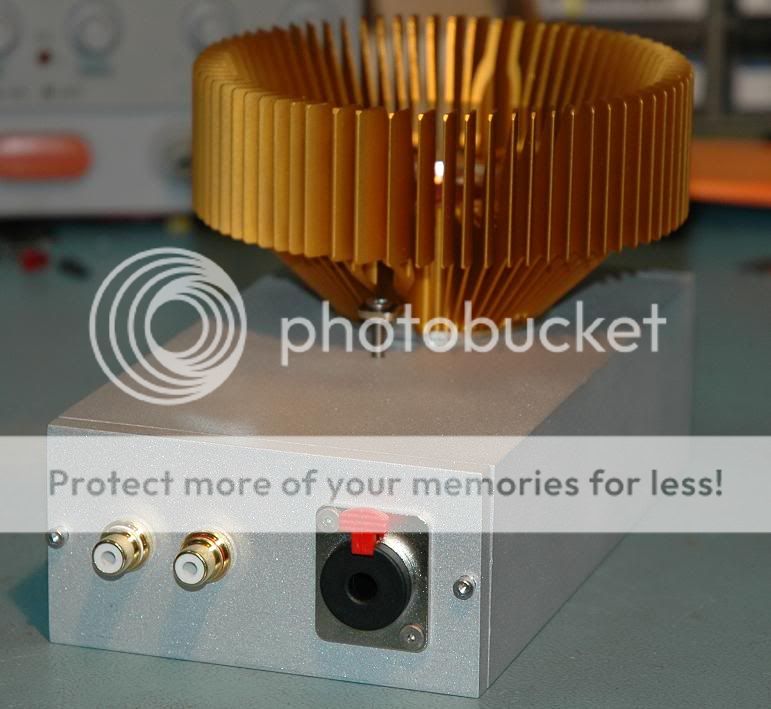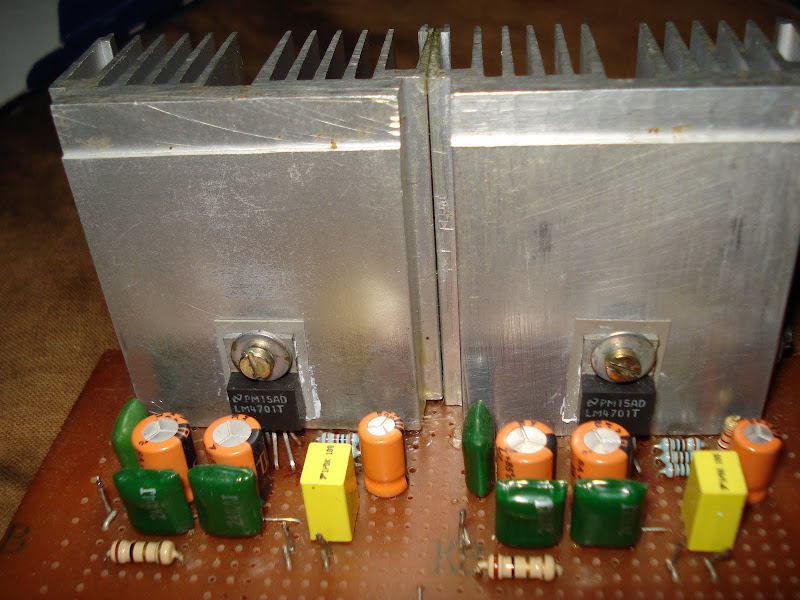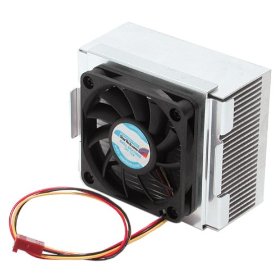Hello everyone
has everyone tried to use a CPU cooler in building a class A amp?
i'm thinking about something like the photo attached (or maybe something less ugly), which are commonly available and quite cheap.
This heatsink are designed to work without a fan, and nowadays computer
produce heaps of heat...so i guess it will work even for audio.
any feedback?
has everyone tried to use a CPU cooler in building a class A amp?
i'm thinking about something like the photo attached (or maybe something less ugly), which are commonly available and quite cheap.
This heatsink are designed to work without a fan, and nowadays computer
produce heaps of heat...so i guess it will work even for audio.
any feedback?
Attachments
Without a fan maybe but, in a box with airflow. There are extra quiet fans available and you can even lower the speed of the fan for very good results 
These things work more efficiently at a relatively high temp.

These things work more efficiently at a relatively high temp.
I found that coolers for CPUs with a very high thermal design power (TDP) are perfectly suited for smaller amps, if you don't use the fan. Passive CPU coolers for such CPUs, like the one above, are probably perfectly suited for higher powers. Just take a look at the TDP of the CPU they were designed for.
My "guesstimates" are the following: a passive cooler for a CPU with a TDP of let's say 100 Watts will probably allow for a 70-80°C die temperature if you pump the whole 100 Watts in there at room temp. So if you have a stereo class A amp with 2 transistors per channel, you could in theory safely put out 2x 40 W RMS while keeping the output transistors at about 80°C.
My "guesstimates" are the following: a passive cooler for a CPU with a TDP of let's say 100 Watts will probably allow for a 70-80°C die temperature if you pump the whole 100 Watts in there at room temp. So if you have a stereo class A amp with 2 transistors per channel, you could in theory safely put out 2x 40 W RMS while keeping the output transistors at about 80°C.
Edit: I was thinking that way, that every transistor has it's own heat sink. All 4 together on one heat sink will probably allow for 2x10 W RMS only.
I've built several pieces using the Zalman products, including
the water towers. They work great.
I pick Zalman because they are the quietest I have found.
the water towers. They work great.
I pick Zalman because they are the quietest I have found.
There is no passive cooling for CPUs with 100W TDP. You must use a fan with any of such heatsinks because the gaps between fins are so small that they need forced air to work effectively. Additional problem with heatpipes is that they stop working at all if you would not cool fins properly.
I have thought about trying the large Scythe Ninja series sinks - the fins are spread far enough for good heat transfer with just a light breeze - basically passive with a single quiet case fan pulling air through the box.
They are also available in copper which might be slightly better. I am not sure about orientation with heat pipe solutions. I am also not sure of the best mounting solution - seems like a clamp would be required to avoid drilling holes through the heat pipes.
The copper version they say can dissapate 65 watts with no fan, 130 with a 'silent' fan.
Pictures: http://www.xbitlabs.com/articles/coolers/display/scythe-ninja-copper_2.html
They are also available in copper which might be slightly better. I am not sure about orientation with heat pipe solutions. I am also not sure of the best mounting solution - seems like a clamp would be required to avoid drilling holes through the heat pipes.
The copper version they say can dissapate 65 watts with no fan, 130 with a 'silent' fan.
Pictures: http://www.xbitlabs.com/articles/coolers/display/scythe-ninja-copper_2.html
Last edited:
CBRworm,
All those "fanless" solutions suppose that you have well ventilated case where the air flow is provided by a case fan (a light breeze).
All those "fanless" solutions suppose that you have well ventilated case where the air flow is provided by a case fan (a light breeze).
I did a quick google and I'm afraid it's true that no passive cooling can be accomplished for TDPs of 100W. I found notes that passive cooling is only for "light loads" like "browsing, emailing" and so on. I stand corrected. 🙂
On topic of (forced) ventilation. I have an AMD K6-350 underclocked to 166 MHz. I stripped the heat sink of it's noisy fan. The processor got rather hot with some 52°C according to the mobo's sensors. Then, I installed a large fan on that heat sink running on 5V instead of 12V. You almost can't hear that fan when it's on. The temperature never rose above 25°C, ambient being 20-21°C. Looks like forced ventilation is a must.
On topic of (forced) ventilation. I have an AMD K6-350 underclocked to 166 MHz. I stripped the heat sink of it's noisy fan. The processor got rather hot with some 52°C according to the mobo's sensors. Then, I installed a large fan on that heat sink running on 5V instead of 12V. You almost can't hear that fan when it's on. The temperature never rose above 25°C, ambient being 20-21°C. Looks like forced ventilation is a must.
I got a pair of laser diode water blocks and two 2-fan radiators.
http://cgi.ebay.com/Water-Cooled-He...in_0?hash=item230256b149&_trksid=p3286.c0.m14
I am going to run the it all in one loop for temp stability between channels. I am going to use two water pumps in parallel in case one fails, same goes for the fans. The fans are wired to a 29amp 12V smps along with all of the lighting for the house to keep the noisy fans isolated. The temp/fan control is my only gray area. I don't want to use a PC fan controller because I don't want the PC on ifI am not listening to that source.
For the temp/fan control I was going to use a 3-pin voltage reg with a 5k pot, a 5K thermistor and a temp probe to monitor it. I can fire up the amps and wait for the water temp to reach 55F and then adjust the pot until the fans start. This way as the temp increases the fan speed increases. I think this will work and be as close to fail safe as possible. I am not doing this for the cost savings because it will cost me more. I am doing it for the weight saving for when I ship it overseas to my new home and for the heat to be remove from my tropical house. Radiators outside will save me a fortune on cooling the house after two F4's heatit up. I was also thinking of running a huge resevoir and using it for a hot water heater, 55deg water will make a nice shower temp. If I go this route I would use DC water pump that are hooked to the thermistor setup to run the pumps at higher speeds when the temp starts to rise. I was also going to seal the PC, DAC, amp, preamp, all in one box so that it is airtight with a rad inside and rad outside to keep the humidity and animals out. Remember, this might be needed to make it last in the rainforest.
http://cgi.ebay.com/Water-Cooled-He...in_0?hash=item230256b149&_trksid=p3286.c0.m14
I am going to run the it all in one loop for temp stability between channels. I am going to use two water pumps in parallel in case one fails, same goes for the fans. The fans are wired to a 29amp 12V smps along with all of the lighting for the house to keep the noisy fans isolated. The temp/fan control is my only gray area. I don't want to use a PC fan controller because I don't want the PC on ifI am not listening to that source.
For the temp/fan control I was going to use a 3-pin voltage reg with a 5k pot, a 5K thermistor and a temp probe to monitor it. I can fire up the amps and wait for the water temp to reach 55F and then adjust the pot until the fans start. This way as the temp increases the fan speed increases. I think this will work and be as close to fail safe as possible. I am not doing this for the cost savings because it will cost me more. I am doing it for the weight saving for when I ship it overseas to my new home and for the heat to be remove from my tropical house. Radiators outside will save me a fortune on cooling the house after two F4's heatit up. I was also thinking of running a huge resevoir and using it for a hot water heater, 55deg water will make a nice shower temp. If I go this route I would use DC water pump that are hooked to the thermistor setup to run the pumps at higher speeds when the temp starts to rise. I was also going to seal the PC, DAC, amp, preamp, all in one box so that it is airtight with a rad inside and rad outside to keep the humidity and animals out. Remember, this might be needed to make it last in the rainforest.
I'm surprised more people aren't doing this.. P4's ran hotter than dual cores, and have some relatively nice heatsinks. And, P4's are worthless now days.. I collect many of them each week (technology consultant) which are destined for the dump.
-kicking myself for not using some free heat sinks I've already got, on this latest project...
-kicking myself for not using some free heat sinks I've already got, on this latest project...
Last edited:
I've worked a lot with Sun servers, and many of them are designed like a wind tunnel. This isn't practical for a DIY PC, where the heatsink is "generic", but it *could* work for an amplifier. Basically air is sucked in from the front of the chassis, and then blown out the back via a series of fans. Picture a giant hair dryer and you get the general idea.
The key is that the internals are subdivided, so the components that need air circulation get the bulk of it. (IE, the disks are on one side, the CPUs on the other.)
Here's a pic; note the front of the chassis is sculpted to draw air through the enclosure.
The key is that the internals are subdivided, so the components that need air circulation get the bulk of it. (IE, the disks are on one side, the CPUs on the other.)
Here's a pic; note the front of the chassis is sculpted to draw air through the enclosure.
An externally hosted image should be here but it was not working when we last tested it.
I am currently waiting on some parts to build a hybrid cooling case. Using Conrad MF35 heatsinks with two fans mounted under the sinks to assist, I hope to cut the thermal resistance of the conrads in half.
I ordered Noctua flex fans, they are highly rated and seem to be the quitest available plus can be wired for 600, 900 and 1200 rpms with a 12v supply. The db rating is only 6, 10 and 18 for the three settings.
I hope this layout will allow me to build larger class a amps without spending all of my budget on AL.
I ordered Noctua flex fans, they are highly rated and seem to be the quitest available plus can be wired for 600, 900 and 1200 rpms with a 12v supply. The db rating is only 6, 10 and 18 for the three settings.
I hope this layout will allow me to build larger class a amps without spending all of my budget on AL.
Attachments
http://www.head-fi.org/forums/f6/ad8397-class-188758/#post2263321

I wanted passive cooling and this looked the most likely to give good free air performance

I wanted passive cooling and this looked the most likely to give good free air performance
Still my favorite in fanless cooling of lower-power CPUs:
But, the reason we're not seeing people use these for cooling electronics apart from CPUs - how are you going to mount this thing when your PCB and mounting mechanism doesn't follow the required standards.
Otherwise, I'd gladly spend $50 on such a heatsink than $200 for a custom-made heatsink "for audio" chassis that performs 1/4 as good.
An externally hosted image should be here but it was not working when we last tested it.
But, the reason we're not seeing people use these for cooling electronics apart from CPUs - how are you going to mount this thing when your PCB and mounting mechanism doesn't follow the required standards.
Otherwise, I'd gladly spend $50 on such a heatsink than $200 for a custom-made heatsink "for audio" chassis that performs 1/4 as good.
Last edited:
PC HEatsinKZ!
This is my LM4701 Amp using P3 Heatsinks. This was the first where I used a PC HS and the result was absolutely great.

I recently made a couple of SE Class-A amps and used one Pentium 4 Rectangular HS for each power MOSFET (4 total) and they are simply Robust. Even with 44 watts dissipated in each device the temperature is well controlled and no fan is needed. Well they are fairly warm, but stable.

This is my LM4701 Amp using P3 Heatsinks. This was the first where I used a PC HS and the result was absolutely great.
I recently made a couple of SE Class-A amps and used one Pentium 4 Rectangular HS for each power MOSFET (4 total) and they are simply Robust. Even with 44 watts dissipated in each device the temperature is well controlled and no fan is needed. Well they are fairly warm, but stable.

Last edited:
The problem with CPU heatsinks that they must get forced air flow otherwise they work very poorly because of small gaps between fins. Using a fan leads to two problems - noise and dust.
These days heat sink cleaning is becoming a standard household cleaning task, and at the savings of ~$150, it's not a bad option... especially for experimenting (as in, an amp to tweak and play around with.. not sell)
- Status
- Not open for further replies.
- Home
- Amplifiers
- Pass Labs
- PC-like cooling?


